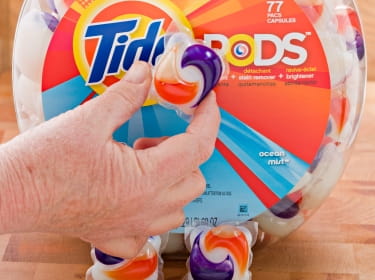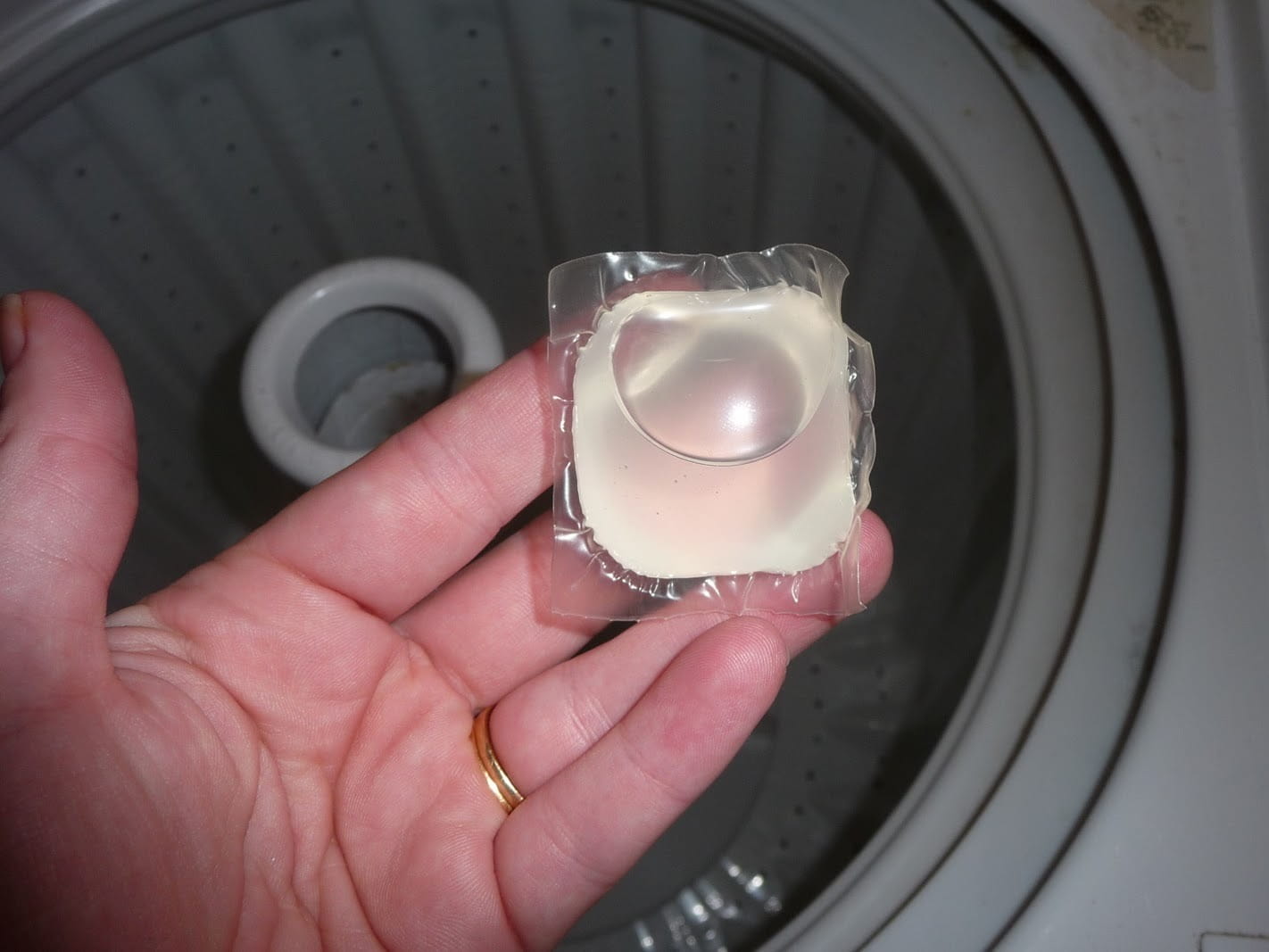What Happens if a Child Eats a Tide Pod?

The Bottom Line
Laundry detergent pods are popular and convenient household products. Potential effects of biting into a laundry detergent pod include coughing, choking, trouble breathing, and coma. The detergent also can irritate the skin and burn the eyes.

What are laundry detergent pods?
One of the newest ways to wash clothes is by dropping a "pod" of detergent into a washing machine. The pods are easy to handle, the detergent is pre-measured, and there are no spills. The coating of the pod dissolves in the wash. These convenient pods entered the US market in 2010 after almost a decade of use in Europe.Are laundry detergent pods toxic?
Not long after the introduction of laundry detergent pods, the CDC issued a report that stated, “Exposure to laundry detergent in pods, especially among children aged [5 years or younger], is an emerging public health hazard in the United States.”
These convenient pods pose a hazard for children who bite into them. Many require hospital treatment, and some need treatment in intensive care units. Serious effects can occur quickly. They include severe vomiting, severe breathing trouble, burns to the esophagus, and coma. The liquid from laundry pods can also burn the eyes and skin.
Are laundry detergent pods getting safer?
Voluntary safety standards for laundry detergent pods were published in 2015. Since then, the rate of exposures has decreased by about 30%, and the rate of cases needing medical treatment has decreased by about 40%. However, several studies have found that laundry detergent pod exposures are still more likely to cause symptoms, require medical attention, and have serious outcomes than exposures to traditional laundry products.
Manufacturers continue to develop more secure packaging for laundry detergent pods. Even with these new containers, it is still important to keep detergent pods away from children. Always close the container tightly after removing a pod. Store detergent pods where children cannot see or reach them.
What should I do if a child eats a laundry detergent pod?
If a child bites into a detergent pod, remove the pod immediately. Wash the child's face and hands. Gently wipe out the child's mouth. Then, use the webPOISONCONTROL online tool or guidance, or call Poison Control at 1-800-222-1222.
If pod contents squirt into a child's eye, rinse the eye with gently running water for 15 minutes. Then, use the webPOISONCONTROL online tool for guidance or call Poison Control for advice.
Rose Ann Gould Soloway, RN, BSN, MSEd, DABAT emerita
Clinical Toxicologist
Revised William G. Troutman, PharmD
Professor of Pharmacy Emeritus
Poison Control Media Information
Did you find this page helpful? If so, we need your support. Poison Control is in constant competition with misinformation online. Links to www.poison.org or our webPOISONCONTROL triage tool from other websites and blogs help internet searchers quickly find accurate information and Poison Control’s contact information in an emergency. If you use the content from this page, please provide attribution via a link back to this page, www.poison.org, or https://triage.webpoisoncontrol.org/#!/exclusions. By doing so, you could save a life. Thank you!
Poisoned?
Call 1-800-222-1222 or
Prevention Tips
- Keep laundry detergent pods (and other cleaning products) out of sight and reach of children.
- Use the locks on laundry pod containers after removing a pod—every time. (This also protects the contents, which dissolve on contact with moisture.)
- Do not cut, tear, or puncture laundry pods.
This Really Happened
Case 1. An older sibling watched a 10-month-old girl ingest a laundry detergent pod. Her mother took her to a local hospital emergency room. By then, the girl was having trouble breathing and had become less responsive. Her chest x-ray was clear. She vomited several times, and her vomit began to show evidence of blood. She was transferred to a children’s hospital and admitted to its pediatric intensive care unit. She was found to have a lot of swelling in her throat, and even thin liquids leaked into her lungs. She was discharged from the hospital after 7 days while still being fed through a stomach tube. After 3 weeks, she was able to safely swallow thin liquids on her own (from Beuhler et al., 2013).Case 2. A 20-month-old boy bit into a laundry detergent pod. Within 15 minutes, he vomited and became drowsy. He became less responsive and had trouble breathing, so he was taken to an emergency room by ambulance. In the ER, he was described as “minimally responsive.” His breathing was noisy, and he was intubated. A chest x-ray showed evidence of aspiration. Later that day, the breathing tube was removed, and he received medication to reduce swelling in his respiratory tract. The boy was discharged from the hospital the next day but was brought back a day later because of diarrhea and wheezing. Although his lungs were improved, they still showed evidence of aspiration. The boy was sent home, and follow-up calls found that he did well (from Beuhler et al., 2013).
For More Information
Laundry Room and Detergent Safety | American Academy of Pediatrics
Single-Load Liquid Laundry Packets: Harmful to Children | US Consumer Products Safety Commission
Liquid Laundry Packet Safety Standard | American Cleaning Institute
References
Gray ME, West CE. Corneal injuries from liquid detergent pods. J AAPOS. 2014;18(5):494-495.
Zhang AM, Smith GA, Casavant MJ, Kistamgari S, Gaw CE. Longitudinal trends in liquid laundry detergent packet exposures: 2014-2022. Clin Toxicol (Phila). 2023;61(11):990-998.
Poisoned?
Call 1-800-222-1222 or
Prevention Tips
- Keep laundry detergent pods (and other cleaning products) out of sight and reach of children.
- Use the locks on laundry pod containers after removing a pod—every time. (This also protects the contents, which dissolve on contact with moisture.)
- Do not cut, tear, or puncture laundry pods.
This Really Happened
Case 1. An older sibling watched a 10-month-old girl ingest a laundry detergent pod. Her mother took her to a local hospital emergency room. By then, the girl was having trouble breathing and had become less responsive. Her chest x-ray was clear. She vomited several times, and her vomit began to show evidence of blood. She was transferred to a children’s hospital and admitted to its pediatric intensive care unit. She was found to have a lot of swelling in her throat, and even thin liquids leaked into her lungs. She was discharged from the hospital after 7 days while still being fed through a stomach tube. After 3 weeks, she was able to safely swallow thin liquids on her own (from Beuhler et al., 2013).Case 2. A 20-month-old boy bit into a laundry detergent pod. Within 15 minutes, he vomited and became drowsy. He became less responsive and had trouble breathing, so he was taken to an emergency room by ambulance. In the ER, he was described as “minimally responsive.” His breathing was noisy, and he was intubated. A chest x-ray showed evidence of aspiration. Later that day, the breathing tube was removed, and he received medication to reduce swelling in his respiratory tract. The boy was discharged from the hospital the next day but was brought back a day later because of diarrhea and wheezing. Although his lungs were improved, they still showed evidence of aspiration. The boy was sent home, and follow-up calls found that he did well (from Beuhler et al., 2013).
